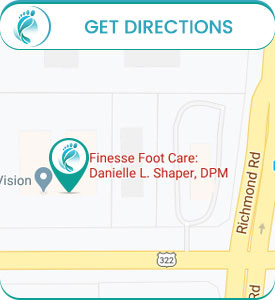Foot and Ankle Pain Treatment Specialist Q&A
Overuse or injury are the most frequent causes of pain in the feet or ankles. Most foot and ankle issues can be treated with physical therapy, steroid injections, anti-inflammatory drugs, braces, shoe orthotics, or even custom shoes. If you believe that your foot or ankle discomfort is a result of an injury, visit Dr. Danielle L. Shaper at Finesse Footcare. He can assist in diagnosing and treating foot and ankle issues. Contact us today for more information or schedule an appointment online. We are conveniently located at 5035 Mayfield Rd Lyndhurst, OH 44124.


Table of Contents:
What can cause foot and ankle pain without injury?
What are the common symptoms of ankle pain?
How do you relieve foot and ankle pain?
When should I see a healthcare professional about foot and ankle pain?
Foot and ankle pain can be because of a myriad of factors aside from direct injury, such as underlying health conditions and biomechanical issues. For instance, diabetes can lead to peripheral neuropathy, causing sensations of pain, numbness, and tingling in the feet, while infections like osteomyelitis or cellulitis can also manifest as foot discomfort. Systemic diseases like rheumatoid arthritis or fibromyalgia may cause inflammation in the joints and soft tissues, contributing to persistent foot pain. Biomechanical factors, including overpronation or supination, muscle imbalances, or structural foot abnormalities, can result in undue stress and strain on the feet and ankles, which can cause some discomfort. Additionally, conditions like bursitis or tendinitis can cause localized inflammation and pain in these areas. Seeking medical attention for non-injury-related foot and ankle pain is crucial to determining the root cause and developing a unique treatment plan to handle the underlying concerns and alleviate symptoms effectively, ultimately promoting optimal foot health and functionality.
Ankle pain is a complex and multifaceted issue characterized by an array of symptoms that can be different in intensity and presentation. Some individuals may experience localized swelling, redness, and warmth around the ankle joint, indicating inflammation and potential underlying damage. Tenderness to the touch, particularly around specific areas of the ankle, such as the ligaments or tendons, may indicate an acute injury or overuse strain. Bruising and discoloration can also be present, especially in cases of trauma or sprains. Stiffness and limited range of motion in the ankle joint can make simple movements challenging and may be a sign of more chronic issues like arthritis or tendinopathy. Instability or a feeling of the ankle “giving way” can point to ligament laxity or weakness, predisposing individuals to recurrent injuries. Pain while bearing weight on the affected ankle, especially during activities or weight-bearing exercises, is a common complaint that should not be ignored, as it can indicate structural damage or degenerative changes within the joint. Understanding and recognizing these symptoms is crucial for proper diagnosis and targeted treatment to address the root cause of ankle pain effectively.
Relieving foot and ankle pain can involve several strategies, such as rest, ice, compression, elevation (RICE method), over-the-counter pain medications like ibuprofen or acetaminophen for pain and inflammation, proper footwear or orthotic inserts for support and alignment, gentle stretching and strengthening exercises to improve flexibility and stability, physical therapy, massage therapy, and in some cases, immobilization with a brace or splint. Additionally, avoiding high-impact activities, modifying exercise routines, and gradually returning to normal activities post-injury can help prevent further strain and promote healing. Meeting with a healthcare professional for an accurate diagnosis and personalized treatment plan is essential for addressing foot and ankle pain effectively and avoiding any potential complications.
If you’re dealing with foot and ankle pain, it’s crucial to know when to seek advice from a healthcare professional. Severe or persistent pain that doesn’t improve with rest, icing, or over-the-counter pain medications may indicate a more serious underlying issue that requires medical attention. Swelling, bruising, or redness that persists or worsens can be signs of inflammation, strain, or even fractures, which need to be properly evaluated and treated by a professional. Unable to put weight on the affected foot, a visible deformity, or misalignment following an injury should not be overlooked either, as they might require immediate medical intervention to prevent further damage. Signs of infection like warmth, fever, or draining wounds in the foot area shouldn’t be ignored, as infections can escalate quickly without proper treatment. Additionally, numbness, tingling, or burning sensations in the foot or toes could indicate nerve damage or other neurological issues that need to be addressed promptly. If you have a history of chronic conditions like arthritis or diabetes that affect foot health, any new or worsening pain should prompt a visit to a healthcare provider to prevent complications from arising. It’s essential to prioritize your foot health and not hesitate to seek professional guidance when pain or discomfort persists. Contact us today for more information or schedule an appointment online. We serve patients from Lyndhurst OH, Chagrin Falls OH, Beachwood OH, Collinwood OH, Pepper Pike OH, Woodmere OH, Hunting Valley OH, and surrounding areas.




